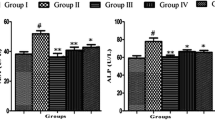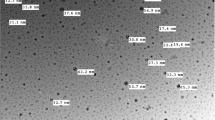Abstract
Curcumin (Cur) effects on renal injury induced by zinc oxide nanoparticles (NZnO) in rats were investigated. NZnO at a dose of 50 mg/kg for 14 days was administered to rats as intoxicated group. In protection group, Cur at a dose of 200 mg/kg was administered for 7 days prior to NZnO treatment and followed by concomitant administration of NZnO for 14 days. Plasma concentrations of uric acid, creatinine (Cr), and blood urea nitrogen (BUN) were detected to evaluate renal injury. Malondialdehyde (MDA), superoxide dismutase (SOD), and glutathione peroxidase (GPx) levels were determined for evaluation oxidative stress. TUNEL staining and histological changes were also performed. Administration of NZnO caused a significant elevation in the uric acid, Cr, and BUN levels. Oxidative stress was increased in the kidney by NZnO through enhancing MDA contents and reducing activities of SOD and GPx enzymes. According to histological examinations, treatment with NZnO caused proximal tubule damages, which was accompanied by the accumulation of red blood cells, infiltration of inflammatory cells, and reducing glomerular diameters. Significant increase was observed in the apoptotic index of the renal tubules in NZnO-treated rats. In present work, pretreatment of Cur reduced the histological changes, decreased biomarker levels, attenuated apoptotic index, and ameliorated oxidative stress by decreasing the MDA contents and increasing the activities of SOD and GPx enzymes. These findings indicate that Cur effectively protects against NZnO-induced nephrotoxicity in the rats.






Similar content being viewed by others
References
Ak T, Gülçin I (2008) Antioxidant and radical scavenging properties of curcumin. Chem Biol Interact 174(1):27–37
Alidadi H, Khorsandi L, Shiran M (2018) Effects of quercetin on tubular cell apoptosis and kidney damage in rats induced by titanium dioxide nanoparticles. Malays J Med Sci 25(2):72–81
Almansour MI, Alferah MA, Shraideh ZA, Jarrar BM (2017) Zinc oxide nanoparticles hepatotoxicity: histological and histochemical study. Environ Toxicol Pharmacol 51:124–130
Bisht S, Bhakta G, Mitra S, Maitra A (2005) pDNA loaded calcium phosphate nanoparticles: highly efficient non-viral vector for gene delivery. Int J Pharm 288(1):157–168
Borm PJA, Kreyling W (2004) Toxicological hazards of inhaled nanoparticles-potential implications for drug delivery. J Nanosci Nanotechnol 4(5):521–531
Buyuklu M, Kandemir FM, Ozkaraca M, Set T, Bakirci EM, Topal E (2014) Protective effect of curcumin against contrast induced nephropathy in rat kidney: what is happening to oxidative stress, inflammation, autophagy and apoptosis? Eur Rev Med Pharmacol Sci 18(4):461–470
Chang MC, Chan CP, Wang YJ, Lee PH, Chen LI, Tsai YL, Lin BR, Wang YL, Jeng JH (2007) Induction of necrosis and apoptosis to KB cancer cells by sanguinarine is associated with reactive oxygen species production and mitochondrial membrane depolarization. Toxicol Appl Pharmacol 218:143–151
Chien CC, Yan YH, Juan HT, Cheng TJ, Liao JB, Lee HP, Wang JS (2017) Sustained renal inflammation following 2 weeks of inhalation of occupationally relevant levels of zinc oxide nanoparticles in Sprague Dawley rats. J Toxicol Pathol 30(4):307–314
Cho WS, Kang BC, Lee JK, Jeong J, Che JH (2013) Seok SH (2013) comparative absorption, distribution, and excretion of titanium dioxide and zinc oxide nanoparticles after repeated oral administration. Part Fibre Toxicol 10:9
De R, Kundu P, Swarnakar S, Ramamurthy T, Chowdhury A, Nair GB, Mukhopadhyay AK (2009) Antimicrobial activity of curcumin against helicobacter pylori isolates from India and during infections in mice. Antimicrob Agents Chemother 53(4):1592–1597
Edwards RL, Luis PB, Varuzza PV, Joseph AI, Presley SH, Chaturvedi R, Schneider C (2017) The anti-inflammatory activity of curcumin is mediated by its oxidative metabolites. J Biol Chem 292(52):21243–21252
El-Maddawy ZK, El-Sayed YS (2018) Comparative analysis of the protective effects of curcumin and N-acetyl cysteine against paracetamol-induced hepatic, renal, and testicular toxicity in Wistar rats. Environ Sci Pollut Res Int 25(4):3468–3479
El-Zawahry BH, Abu El Kheir EM (2007) The protective effect of curcumin against gentamicin-induced renal dysfunction and oxidative stress in male albino rats. Egypt J Hosp Med 29:546–556
Farombi EO, Shrotriya S, Na HK, Kim SH, Surh YJ (2008) Curcumin attenuates dimethylnitrosamine-induced liver injury in rats through Nrf2-mediated induction of heme oxygenase-1. Food Chem Toxicol 46(4):1279–1287
Fialkow L, Wang Y, Downey GP (2007) Reactive oxygen and nitrogen species as signaling molecules regulating neutrophil function. Free Radic Biol Med 42(2):153–164
Guan R, Kang T, Lu F, Zhang Z, Shen H, Liu M (2012) Cytotoxicity, oxidative stress, and genotoxicity in human hepatocyte and embryonic kidney cells exposed to ZnO nanoparticles. Nanoscale Res Lett 7(1):1–7
Han Z, Yan Q, Ge W, Liu ZG, Gurunathan S, De Felici M, Shen W, Zhang XF (2016) Cytotoxic effects of ZnO nanoparticles on mouse testicular cells. Int J Nanomedicine 11:5187–5203
He L, Peng X, Zhu J, Liu G, Chen X, Tang C, Liu H, Liu F, Peng Y (2015) Protective effects of curcumin on acute gentamicin-induced nephrotoxicity in rats. Can J Physiol Pharmacol 93(4):275–282. https://doi.org/10.1139/cjpp-2014-0459
John S, Marpu S, Li J, Omary M, Hu Z, Fujita Y, Neogi A (2010) Hybrid zinc oxide nanoparticles for biophotonics. J Nanosci Nanotechnol 10(3):1707–1712
Jones EA, Shahed A, Shoskes DA (2000) Modulation of apoptotic and inflammatory genes by bioflavonoids and angiotensin II inhibition in ureteral obstruction. Urology 56(2):346–351
Khan S, Vala JA, Nabi SU, Gupta G, Kumar D, Telang AG, Malik JK (2012) Protective effect of curcumin against arsenic-induced apoptosis in murine splenocytes in vitro. J Immunotoxicol 9(2):148–159
Kim KS, Lim HJ, Lim JS, Son JY, Lee J, Lee BM, Chang SC, Kim HS (2018) Curcumin ameliorates cadmium-induced nephrotoxicity in Sprague-Dawley rats. Food Chem Toxicol 114:34–40
Khazaei Koohpar Z, Entezari M, Movafagh A, Hashemi M (2015) Anticancer activity of curcumin on human breast adenocarcinoma: role of mcl-1gene. Iran J Cancer Prev 8(3):e2331
Khorsandi LS, Hashemitabar M, Orazizadeh M, Albughobeish N (2008) Dexamethasone effects on fas ligand expression in mouse testicular germ cells. Pak J Biol Sci 11(18):2231–2236
Kuhad A, Pilkhwal S, Sharma S, Tirkey N, Chopra K (2007) Effect of curcumin on inflammation and oxidative stress in cisplatin-induced experimental nephrotoxicity. J Agric Food Chem 55(25):10150–10155
Lin YF, Chiu IJ, Cheng FY, Lee YH, Wang YJ, Hsu YH (2016) Chiu HW (2016) the role of hypoxia-inducible factor-1α in zinc oxide nanoparticle-induced nephrotoxicity in vitro and in vivo. Part Fibre Toxicol 13:52. https://doi.org/10.1186/s12989-016-0163-3
Liu FH, Ni WJ, Wang GK, Zhang JJ (2016) Protective role of curcumin on renal ischemia reperfusion injury via attenuating the inflammatory mediators and Caspase-3. Cell Mol Biol (Noisy-le-grand) 62(11):95–99
Mahgoub E, Kumaraswamy SM, Kader KH, Venkataraman B, Ojha S, Adeghate E, Rajesh M (2017) Genipin attenuates cisplatin-induced nephrotoxicity by counteracting oxidative stress, inflammation, and apoptosis. Biomed Pharmacother 93:1083–1097
Marisa I, Matozzo V, Munari M, Binelli A, Parolini M, Martucci A, Franceschinis E, Brianese N, Marin MG (2016) In vivo exposure of the marine clam Ruditapes philippinarum to zinc oxide nanoparticles: responses in gills, digestive gland and haemolymph. Environ Sci Pollut Res Int 23(15):15275–15293
Moridian M, Khorsandi L, Talebi AR (2015) Morphometric and stereological assessment of the effects of zinc oxide nanoparticles on the mouse testicular tissue. Bratisl Lek Listy 116(5):321–325
Morsy MA, Ibrahim SA, Amin EF, Kame MY, Rifaai RA, Hassan MK (2013) Curcumin ameliorates methotrexate-induced nephrotoxicity in rats. Adv Pharmacol Sci 2013:1–7. https://doi.org/10.1155/2013/387071
Mozaffari Z, Parivar K, Hayati Roodbari N, Irani S (2015) Histopathological evaluation of the toxic effects of zinc oxide (ZnO) nanoparticles on testicular tissue of NMRI adult mice. Adv Stud Biol 7(6):275–291
Nohynek GJ, Jr L, Ribaud C, Roberts MS (2007) Grey goo on the skin? Nanotechnology, cosmetic and sunscreen safety. CRC Crit Rev Toxicol 37(3):251–277
Noori A, Karimi F, Fatahian S, Yazdani F (2014) Effects of zinc oxide nanoparticles on renal function in mice. Int J Biosci 5(9):140–146
Pari L, Murugan P (2007) Antihyperlipidemic effect of curcumin and tetrahydrocurcumin in experimental type 2 diabetic rats. Ren Fail 29(7):881–889
Park S, Lee YK, Jung M, Kim KH, Chung N, Ahn E-K, Lim Y, Lee KH (2007) Cellular toxicity of various inhalable metal nanoparticles on human alveolar epithelial cells. Inhal Toxicol 19(S1):59–65
Sha J, Sui B, Su X, Meng O, Zhang C (2016) Alteration of oxidative stress and inflammatory cytokines induces apoptosis in diabetic nephropathy. 16(5):7715–7723
Sharma V, Singh P, Pandey AK, Dhawan A (2012) Induction of oxidative stress, DNA damage and apoptosis in mouse liver after sub-acute oral exposure to zinc oxide nanoparticles. Mutat Res 45(1–2):84–91
Tankhiwale R, Bajpai SK (2012) Preparation, characterization and antibacterial applications of ZnO-nanoparticles coated polyethylene films for food packaging. Colloids Surf B Biointerfaces 90:16–20
Topcu-Tarladacalisir Y, Sapmaz-Metin M, Karaca T (2016) Curcumin counteracts cisplatin-induced nephrotoxicity by preventing renal tubular cell apoptosis. Ren Fail 38(10):1741–1748
Ueki M, Ueno M, Morishita J, Maekawa N (2013) Curcumin ameliorates cisplatin-induced nephrotoxicity by inhibiting renal inflammation in mice. J Biosci Bioeng 115(5):547–551. https://doi.org/10.1016/j.jbiosc.2012.11.007
Venkatesan N, Punithavathi D, Arumugam V (2000) Curcumin prevents adriamycin nephrotoxicity in rats. Br J Pharmacol 129(2):231–234
Wang C, Lu J, Zhou L, Li J, Xu J, Li W, Zhang L, Zhong X, Wang T (2016) Effects of long-term exposure to zinc oxide nanoparticles on development, zinc metabolism and biodistribution of minerals (Zn, Fe, cu, Mn) in mice. PLoS One 11(10):e0164434. https://doi.org/10.1371/journal.pone.0164434
Wiking L, Larsen T, Sehested J (2008) Transfer of dietary zinc and fat to milk-evaluation of milk fat quality, milk fat precursors, and mastitis indicators. J Dairy Sci 91(4):1544–1551
Wu J, Pan X, Fu H, Zheng Y, Dai Y, Yin Y, Chen Q, Hao Q, Bao D, Hou D (2017) Effect of curcumin on glycerol-induced acute kidney injury in rats. Sci Rep 7(1):10114. https://doi.org/10.1038/s41598-017-10693-4.
Xiao L, Liu C, Chen X, Yang Z (2016) Zinc oxide nanoparticles induce renal toxicity through reactive oxygen species. Food Chem Toxicol 90:76–83
Yan G, Huang Y, Bu Q, Lv L, Deng P, Zhou J, Wang Y, Yang Y, Liu Q, Cen X, Zhao Y (2012) Zinc oxide nanoparticles cause nephrotoxicity and kidney metabolism alterations in rats. J Environ Sci Health A 47(4):577–588
Yousef MI, Omar SAM, El-Guendi MI, Abdelmegid LA (2010) Potential protective effects of quercetin and curcumin on paracetamol-induced histological changes, oxidative stress, impaired liver and kidney functions and haematotoxicity in rat. Food Chem Toxicol 48(11):3246–3261
Zhu HC, Cao RL (2012) The relationship between serum levels of uric acid and prognosis of infection in critically ill patients. World J Emerg Med 3(3):186–190
Funding
This paper was supported by a grant (94s105) from the student research committee council of the Ahvaz Jundishapur University of Medical Sciences.
Author information
Authors and Affiliations
Corresponding author
Additional information
Responsible editor: Philippe Garrigues
Rights and permissions
About this article
Cite this article
Heidai-Moghadam, A., Khorsandi, L. & Jozi, Z. Curcumin attenuates nephrotoxicity induced by zinc oxide nanoparticles in rats. Environ Sci Pollut Res 26, 179–187 (2019). https://doi.org/10.1007/s11356-018-3514-9
Received:
Accepted:
Published:
Issue Date:
DOI: https://doi.org/10.1007/s11356-018-3514-9




